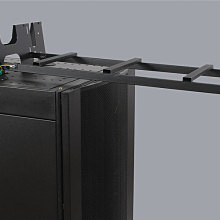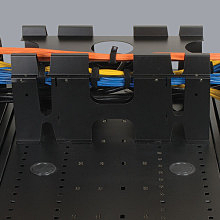I think it’s safe to say that cable clutter is a major problem in most data center or server room rack environments, but how do we fix it?
First, let’s talk about how cables get to the rack. If you have a raised floor, it may seem convenient to route cables under the floor and bring them through the bottom of the rack. The problem is that most people use that under-floor space to route cold air when using a hot-aisle, cold-aisle setup. Cables are not only going to block the flow of cold air, they’re also going to reduce the efficiency of our cold air delivery system another way by causing leaks where they come up through the floor. So if you can avoid routing cables under the floor, that’s what you want to do.

In order to route cables overhead, you can use a system of cable managers, trays, ladders and troughs. Cable managers help organize cables and eliminate stress within cluttered rack cabinet environments. The troughs attach to the roof of each rack and provide channels for routing cables overhead. You’ll typically want to keep some cables apart from each other in separate channels, like power cables and copper network cables because the power cables generate electromagnetic interference that can cause data transmission problems. Another reason to separate bundles is weight. Heavy bundles of copper cables can actually crush fiber cables underneath.

If you have a lot of cable bundles to manage, you can stack the troughs for vertical expansion and extra cable channels. Ladders allow cable bundles to span data center aisles or gaps within rack rows, as well as route cables from the wall or distribution areas to the racks. If the default ladder size doesn’t fit the space, you can link ladders for longer runs or cut them to size for smaller spaces. You can also stack ladders to separate cable types and accommodate more cables.
And last but not least, when you’re tying cable bundles together, zip ties are the traditional choice, but I recommend using cable ties. Hook-and-loop ties give you a little more flexibility and zip ties are easy to over-tighten, which can damage the cables.





